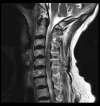Spontaneous Epidural Hematoma of the Cervical Spine in an Elderly Woman with Recent COVID-19 Infection: A Case Report
- PMID: 33028802
- PMCID: PMC7548451
- DOI: 10.12659/AJCR.926784
Spontaneous Epidural Hematoma of the Cervical Spine in an Elderly Woman with Recent COVID-19 Infection: A Case Report
Abstract
BACKGROUND This report presents the case of a woman with no known coagulopathy, use of anticoagulants, or history of trauma who spontaneously developed an epidural hematoma of the spine. This is an uncommon condition, with the potential for missed diagnosis and potential harm to the patient. CASE REPORT The patient was an elderly woman with a history of Type 2 diabetes mellitus and hyperlipidemia. Of note, she had recently recovered from COVID-19. Because the woman presented with right-sided weakness and pain in the back of her neck, the stroke team was activated. A computed tomography (CT) scan of her neck revealed a very subtle hyperdensity, which on further investigation was found to be an acute epidural hematoma at C2-C3 space through the C6 vertebra. While awaiting surgery, the patient had spontaneous improvement of her right-sided weakness and her condition eventually was managed conservatively. CONCLUSIONS Spontaneous spinal epidural hematoma is an uncommon condition, and a high index of suspicion is required to accurately diagnose and appropriately manage it. In the case presented here, the hematoma was subtle on the CT scan, and the patient's weakness easily could have been misdiagnosed as an ischemic stroke. That may have resulted in administration of thrombolytics, potentially causing significant harm. In addition, the patient had recently recovered from COVID-19 disease, which may or may not be incidental. Further observation will be required to determine if there is a spike in similar cases, which may be temporally associated with the novel coronavirus.
Conflict of interest statement
None.
Figures



Similar articles
-
[Spontaneous cervical epidural hematoma presenting with hemiparesis following neck extension: a case report].No Shinkei Geka. 2008 Aug;36(8):731-4. No Shinkei Geka. 2008. PMID: 18700537 Japanese.
-
A spinal epidural hematoma with symptoms mimicking cerebral stroke.Nagoya J Med Sci. 2012 Feb;74(1-2):207-10. Nagoya J Med Sci. 2012. PMID: 22515129 Free PMC article.
-
Imaging and clinical features of patients with 2019 novel coronavirus SARS-CoV-2.Eur J Nucl Med Mol Imaging. 2020 May;47(5):1275-1280. doi: 10.1007/s00259-020-04735-9. Epub 2020 Feb 28. Eur J Nucl Med Mol Imaging. 2020. PMID: 32107577 Free PMC article.
-
[Two cases of spontaneous cervical epidural hematoma mimicking cerebral infarction].No Shinkei Geka. 2014 Feb;42(2):143-8. No Shinkei Geka. 2014. PMID: 24501188 Review. Japanese.
-
Acute Spinal Epidural Hematoma After Acupuncture: Personal Case and Literature Review.World Neurosurg. 2017 Jun;102:695.e11-695.e14. doi: 10.1016/j.wneu.2017.03.125. Epub 2017 Apr 2. World Neurosurg. 2017. PMID: 28377250 Review.
Cited by
-
Treatment refractory acute necrotizing myelitis after COVID-19 vaccine injection: a case report.Ann Med Surg (Lond). 2024 Jan 3;86(2):1185-1190. doi: 10.1097/MS9.0000000000001662. eCollection 2024 Feb. Ann Med Surg (Lond). 2024. PMID: 38333280 Free PMC article.
-
Stroke-like manifestation of a spontaneous spinal epidural hematoma with spontaneous resolution: a case report.Int J Emerg Med. 2023 Feb 20;16(1):10. doi: 10.1186/s12245-023-00478-0. Int J Emerg Med. 2023. PMID: 36803212 Free PMC article.
-
Spontaneous Cervical Epidural Hematoma Following COVID-19 Illness Presenting to a Chiropractor: A Case Report.Cureus. 2022 Dec 5;14(12):e32199. doi: 10.7759/cureus.32199. eCollection 2022 Dec. Cureus. 2022. PMID: 36620842 Free PMC article.
-
A case of spontaneous thoracolumbar epidural hematoma in Covid-19 pneumonia.Int J Surg Case Rep. 2022 Jan;90:106719. doi: 10.1016/j.ijscr.2021.106719. Epub 2021 Dec 23. Int J Surg Case Rep. 2022. PMID: 34961838 Free PMC article.
-
SARS-CoV-2 infection and spontaneous spinal hemorrhage: a systematic review.Neurosurg Rev. 2023 Nov 15;46(1):300. doi: 10.1007/s10143-023-02211-0. Neurosurg Rev. 2023. PMID: 37966587
References
-
- Holtas S, Heiling M, Lönntoft M. Spontaneous spinal epidural hematoma: Findings at MR imaging and clinical correlation. Radiology. 1996;199:409–13. - PubMed
-
- Thiele RH, Hage ZA, Surdell DL, et al. Spontaneous spinal epidural hematoma of unknown etiology: Case report and literature review. Neurocrit Care. 2008;9(2):242–46. - PubMed
-
- Braun P, Kazmi K, Nogués-Meléndez P, et al. MRI findings in spinal subdural and epidural hematomas. Eur J Radiol. 2007;64(1):119–25. - PubMed
-
- Liu WH, Hsieh CT, Chiang YH, Chen GJ. Spontaneous spinal epidural hematoma of thoracic spine: A rare case report and review of literature. Am J Emerg Med. 2008;26(3):384.e1–2. - PubMed
Publication types
MeSH terms
LinkOut - more resources
Full Text Sources
Miscellaneous

